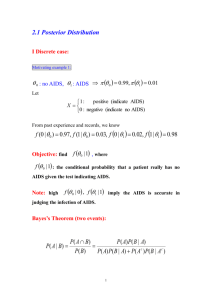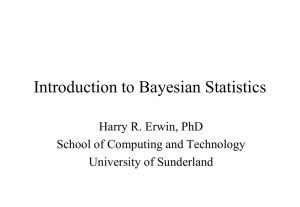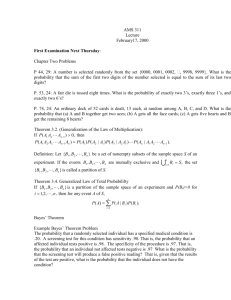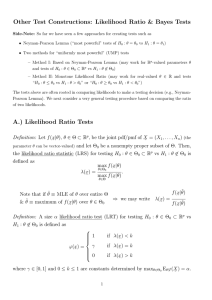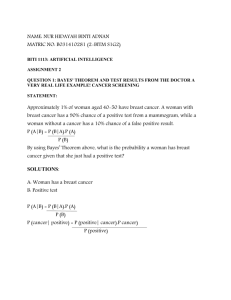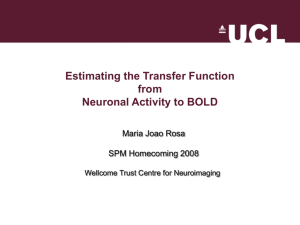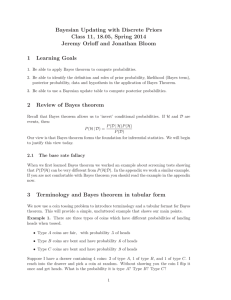Thomas Bayes to the rescue
advertisement
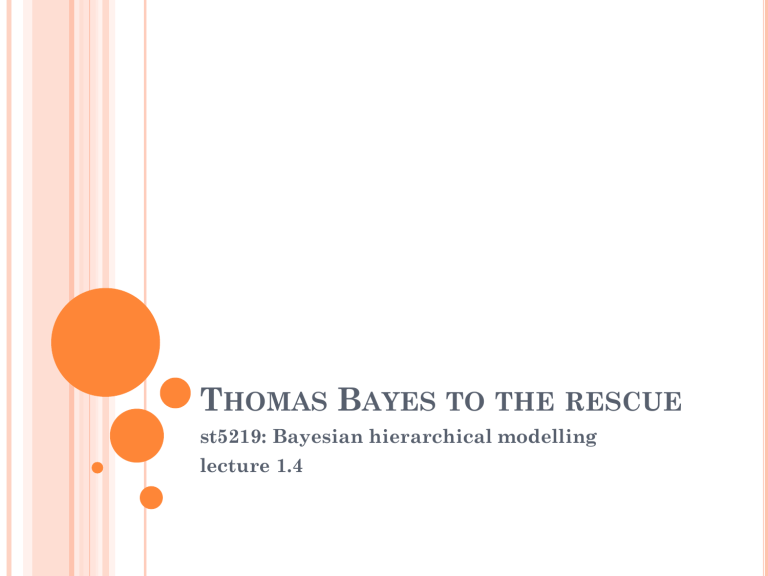
THOMAS BAYES TO THE RESCUE st5219: Bayesian hierarchical modelling lecture 1.4 BAYES THEOREM: MATHS ALERT (You know this already, right?) BAYES THEOREM: APPLICATION You are GP in country like SP Foreign worker comes for HIV test HIV test results come back +ve Does worker have HIV? How to work out? Test sensitivity is 98% Test specificity is 96% ie f(test +ve | HIV +ve) = 0.98 f(test +ve | HIV --ve) = 0.04 BAYES THEOREM: APPLICATION Analogy to hypothesis testing Null hypothesis is not infected Test statistic is test result p-value is 4% Reject hypothesis of non-infection, conclude infected But we calculated: f(+ test | infected) NOT f(infected | + test) BAYES THEOREM: APPLICATION How to work out? Test sensitivity is 98% Test specificity is 96% Infection rate is 1% ie f(test +ve | HIV +ve) = 0.98 f(test +ve | HIV --ve) = 0.04 f(HIV +ve) = 0.01 BAYES THEOREM: APPLICATION BAYES THEOREM: APPLICATION AIDS AND H0S Frequentists happy to use Bayes’ formula here But unhappy to use it to estimate parameters But... If you think it is wrong to use the probability of a positive test given non-infection to decide if infected given a positive test why use the probability of (imaginary) data given a null hypothesis to decide if a null hypothesis is true given data? THE BAYESIAN ID AND FREQUENTIST EGO How do you normally estimate parameters? Is theta hat the most likely parameter value? THE BAYESIAN ID AND FREQUENTIST EGO The parameter that maximises the likelihood function is not the most likely parameter value How can we get the distribution of the parameters given the data? Bayes’ formula tells us likelihood (this is a constant) UPDATING INFORMATION VIA BAYES Can also work with 1. Start with information before the experiment: the prior 2. Add information from the experiment: the likelihood 3. Update to get final information: the posterior • If more data come along later, the posterior becomes the prior for the next time UPDATING INFORMATION VIA BAYES 1. Start with information before the experiment: the prior 2. Add information from the experiment: the likelihood 3. Update to get final information: the posterior UPDATING INFORMATION VIA BAYES 1. Start with information before the experiment: the prior 2. Add information from the experiment: the likelihood 3. Update to get final information: the posterior UPDATING INFORMATION VIA BAYES 1. Start with information before the experiment: the prior 2. Add information from the experiment: the likelihood 3. Update to get final information: the posterior SUMMARISING THE POSTERIOR Mean: Median: Mode: SUMMARISING THE POSTERIOR 95% credible interval: chop off 2.5% from either side of posterior SUMMARISING THE POSTERIOR Bye bye delta approxi mations !!! SOUNDS TOO EASY! WHAT’S THE CATCH?! Here are where the difficulties are: 1. 2. 3. building the model obtaining the posterior model assessment Same issues arise in frequentist statistics (1, 3); estimating MLEs and CIs difficult for non à la carte problems Let’s see an example! Back to AIDS!



